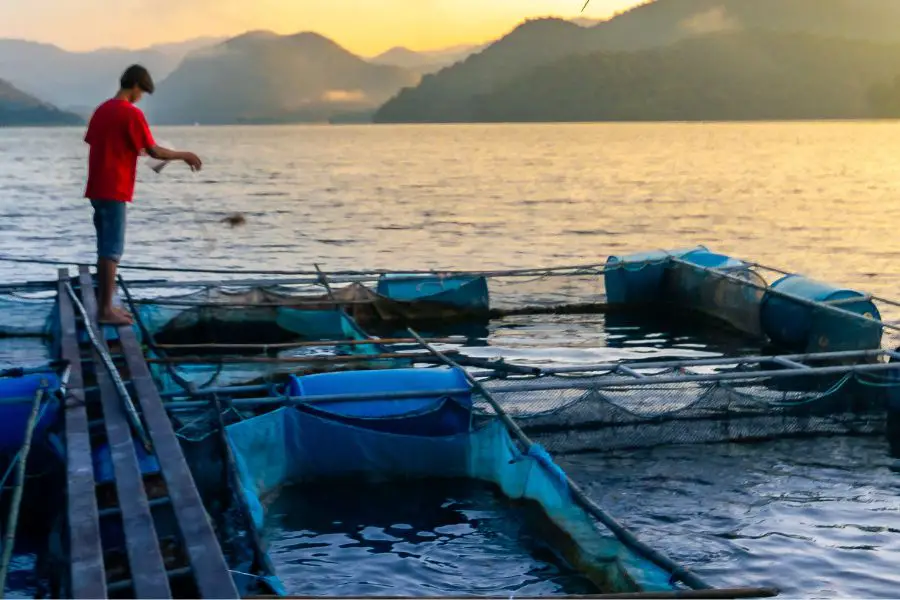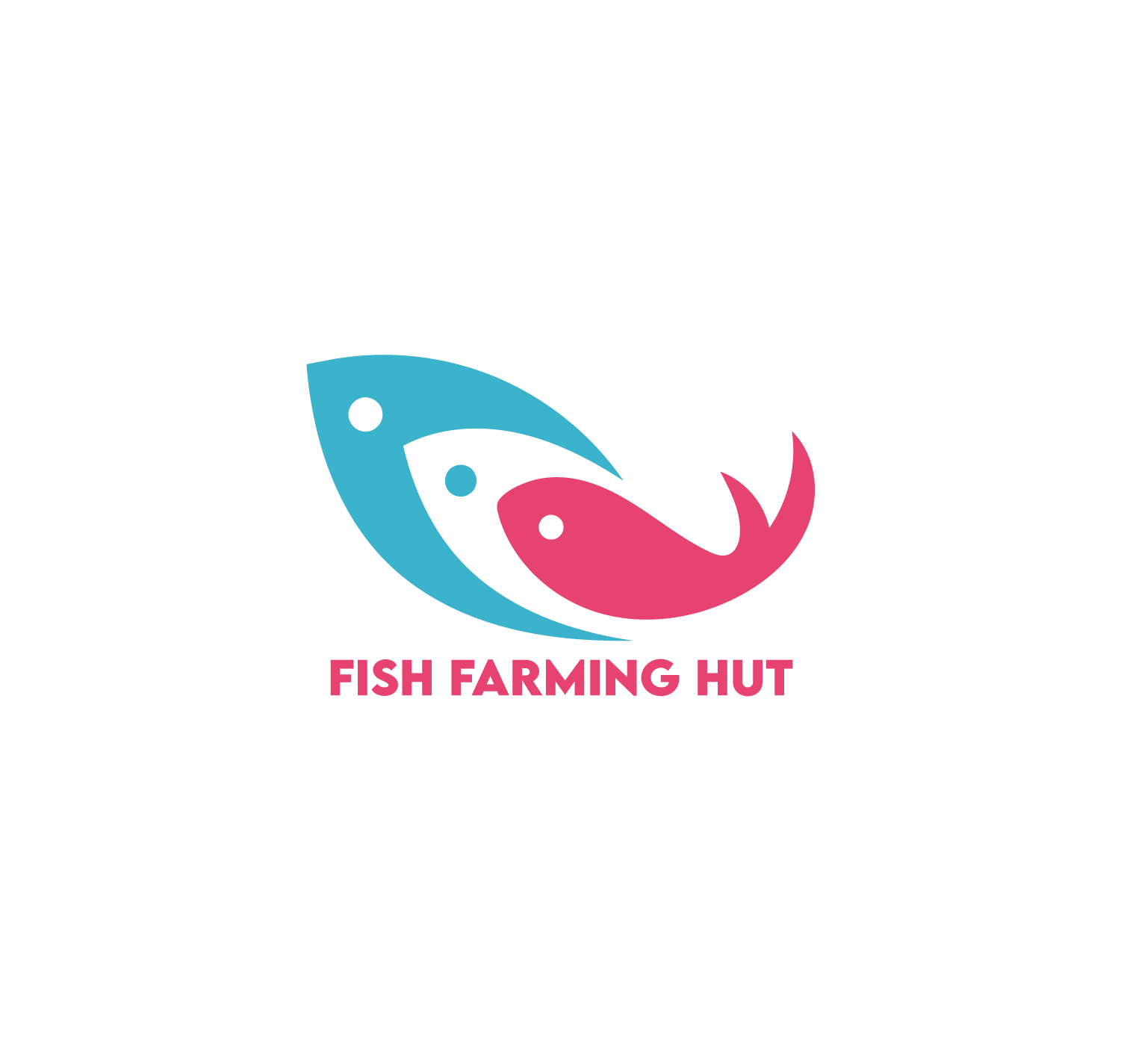Aquaculture is a growing industry around the world, and as it is developing, new techniques are emerging. Farming fish in ponds is by far the most widespread technique used, but fish farming in cages is gradually becoming more and more popular. This method is known as cage aquaculture.
Several different types of cage designs are used for farming fish. The four main types of fish cages are fixed, floating, submersible, and submerged. Within these types, there are various designs. Some cages have flexible netting, while others have rigid netting.
Cage aquaculture uses very basic technology, so the start-up costs are much lower than pond aquaculture. In this article, we discuss the various types of cages used in aquaculture and the factors to consider when choosing a cage design.
What Are Different Types Of Cages Used For Fish Farming?
Cage aquaculture uses four main types of fish cages:
- Fixed cages
- Floating cages
- Submersible cages
- Submerged cages
Within these four categories, there are variations in cage design. Fixed cages are relatively standard, but floating cages vary in size, shape, and design. Fish cages can have either flexible or rigid netting.
The suitability of each cage design depends on the aquaculture site – the water depth, flow conditions, and the environmental setting (river, canal, lake, reservoir, sea). The species of fish being farmed is also a key consideration, as various species have different feeding habits, general behavior, and stocking densities.
1. Fixed Cages Used In Aquaculture
Fixed cages consist of a net bag suspended from posts in the flow of a stream, river, canal, lake, or reservoir. These cages are generally used in shallow bodies of water, with depths of 3 to 10 feet. The bottom of the net bag does not touch the bottom of the water body.
This type of fish cage is very basic and inexpensive to build. Fixed cages are commonly used in small-scale aquaculture, but their use for more extensive, commercial aquaculture is restricted.
2. Floating Cages Used In Aquaculture
Floating cages consist of a frame that floats on the surface of the water. Net bags are suspended from the floating frame so that their bottoms do not touch the ground. These cages are generally used in deeper bodies of water, with depths greater than 16 feet.

The floating frame functions as a walkway so that the nets can be maintained, and the fish can easily be observed and managed.
Floating cages come in a wide range of designs, varying in size and shape. Different designs are developed to be suitable for various conditions in open bodies of water.
3. Submersible Cages For Aquaculture
Submersible cages are a variation of floating cages with either rigid or flexible netting. The buoyancy of plastic floats is variable so that the fish cage can be moved to different depths in the water column. These types of fish cages are often used in marine environments.
4. Submerged Cages For Aquaculture
Submerged cages consist of a solid, rigid frame, wherein a net bag is fitted. The entire cage is submerged underwater, and fish do not have access to the water surface.
This type of cage is not commonly used for aquaculture because they are only suitable for fish without swim bladders and fish with closed swim bladders. Fish with open swim bladders, like salmon and trout, need to access the water's surface to refill their swim bladders and maintain their buoyancy.
Fish Cages With Flexible Netting Versus Cages With Rigid Netting
The primary purposes of the netting used in fish cages are to keep the fish in, keep predators out, and allow water to flow freely through the cage. Two types of netting can be used to serve these functions – flexible or rigid.
Flexible netting for fish cages is most often made of nylon. It is inexpensive and can easily be cleaned and treated with chemicals to prevent biofouling. Biofouling is the build-up of algae and microorganisms on the netting. It reduces the free flow of water through the cage, so it impacts water quality.
Rigid netting used for fish cages is either galvanized or plastic-coated steel mesh or hard plastic, which is more expensive. This type of netting is mostly used in submersible cages. Biofouling is also a problem with rigid netting, and it is more difficult to clean and treat this type of netting. Still, rigid netting has a longer lifespan than flexible nylon netting.
Norweigian-designed Donut Cages For Fish Culture
Norway is a world leader in developing new technology for cage aquaculture, especially for salmon. Norway is the number one producer of farmed salmon in the world.
Salmon farms make use of nearshore areas and fjords along the coastline. Aquaculture in marine environments comes with some challenging issues. Waste management, disease, sea lice, and fish escapes are persistent problems.
To address these issues, a marine contracting firm in Norway, the OPD Group, has designed giant fish cages in the shape of donuts. They look more like structures that belong in outer space than in the ocean!
The donut cages are massive, holding almost 780,000 cubic feet of water. They are 180 feet wide and weigh about 370 metric tons.
These cages create a more closed, controlled environment for the fish. The water temperature inside the cage can be regulated, the water inside the cage can be oxygenated, and fishes’ metabolic waste can be collected and processed in a bioreactor.
The permeability of the netting can be adjusted. When a disease breaks out, the donut cage can isolate the problem by making the net impermeable. This also helps if there is an oil spill nearby.
These donut cages aim to make aquaculture more environmentally sustainable and cost-efficient. In addition, donut cages are much better for the health of the fish.
Fish Farming In Converted Cargo Ships
To farm fish in more exposed marine environments, and to overcome issues like sea lice and fish escapes, retired cargo ships are being converted into fish farms. Like the donut cages, this type of cage culture is intended for high-value fish like salmon.
Repurposing old cargo ships is good for the environment, as a containment vessel does not have to be constructed from scratch. It also brings down the investment cost of setting up such an aquaculture operation.
The tanks of a cargo ship are removed, and in their place, fish cages are installed. The six tanks each have a capacity of almost 23 million cubic feet, giving these vessels the ability to produce nearly a million fish!
As the ship moves slowly, water flows through the cages, helping to maintain good water quality. These aquaculture vessels remain relatively close to the shore so that they can be supplied with onshore electrical power. In addition, they do not run on oil, making food production more environmentally friendly.
Farming Fish In Self-Propelled Cages
AquaPod Net Pens are another innovation in aquaculture technology. These large, spherical cages are automated and self-propelled, making them suitable to deploy in the open ocean. They range between 30 and 90 feet in diameter.
The Aquapods are designed to be fully or partially submerged, and their rigid structure makes them robust enough to handle strong currents. They remain their shape and structure in rough, open sea conditions.
These fish cages are made from triangular panels, similar to a geodesic dome. The frames of the panels are made from high-density polyethylene, and they are covered with vinyl-coated, galvanized steel wire mesh.
Aquapods are modular, so panels can be replaced with ones that have specialized functions, like feeding, fish transfer, size grading, harvesting, or panels that hold scientific instrumentation. They can easily be taken apart, making maintenance relatively easy.
The Aquapods have flotation devices that are pneumatically controlled, giving them the ability to be rotated or moved up or down in the water column.
How To Choose The Cage Design When Starting A Fish Farm?
There are so many types of cages that are suitable for fish farming. Choosing the right type of cage when starting up an aquaculture operation can mean the difference between success and failure.
So, how does one choose the cage design most suitable for a particular fish farm?
The first major factor to consider is whether the fish farm is going to be in a freshwater or marine environment. Next, consider the species of fish that will be farmed and the scale of the aquaculture operation.
For small to medium-scale fish farms in landlocked water bodies, fixed cages (for water depths of 3 to 10 feet) or floating cages (for water depths of over 16 feet) are the best options. They are relatively cheap to set up, and the scale of the operation can easily be expanded.
In coastal marine environments, floating, submersible, or submerged fish cages are suitable. The type of cage depends on the species of fish being farmed.
Fish with swim bladders, like tilapia and salmon need access to the surface of the water. Therefore, floating or submersible cages are required for these species.
Most fish that do not have swim bladders are marine species, like mackerel, cobia, and flounder. These fish can thus be farmed in fully submerged or submersible cages in nearshore environments.
The next critical factor to consider is budget. How much investment capital is there for the initial setup of the aquaculture operation?
Fish cages with flexible nylon netting are the most affordable to procure and the easiest to maintain, especially with floating cages. Cages with rigid metal or plastic netting are pricier and more difficult to maintain (especially submerged cages).
To clean biofouling from submerged cages, divers must be employed to do maintenance on the netting underwater. This is far more costly than hauling the netting up after the cage has been harvested and cleaning the netting above the water.
Advantages Of Farming Fish In Cages Vs In Ponds
The growing popularity of cage aquaculture is due to its many advantages over fish farming in ponds:
- Building cages for fish is quicker, simpler, and less costly than constructing ponds.
- The initial start-up investment required to produce one unit of fish meat is only 30 to 40% of the investment needed for conventional pond aquaculture.
- Cage aquaculture utilizes natural bodies of water, so it does not take up valuable space on land that can be used for other purposes.
- The location and size of cages can easily be changed, so the aquaculture operation can expand more easily.
- Cage culture can be implemented in a wider range of environments than pond aquaculture – canals, natural or artificial lakes, reservoirs, backwaters, and rivers.
- It is easier and quicker to harvest fish in cages.
- Farming fish in cages makes it easier to ensure a steady supply to meet market demands.
- Fish raised in ponds need to be moved into deeper ponds for winter. This is not an issue in cage aquaculture, making this form of fish farming less labor-intensive.
- Due to the high stocking rates, farmed fish are susceptible to diseases. Farming fish in cages rather than ponds allows for easier monitoring of fish’s health, so interventions can happen more quickly.
- Cage aquaculture can be used for sport fishing, as well as for producing fish for meat.
Conclusion
Cage aquaculture is an industry that will see a lot of growth in the coming decades. It is an efficient way to produce healthy, lean protein to meet the demands of our growing human population. There are many different cage designs in aquaculture, suitable for a range of environments, fish species, and scales of production.
The four main types of cages for aquaculture are fixed cages, floating cages, submersible cages, and submerged cages. Within these categories are a wide range of shapes, designs, and technologies ranging from rudimentary to digital. Choosing a type of cage for a particular aquaculture operation is easy if the nature and scale of the farm are established, and the species of fish are known.

